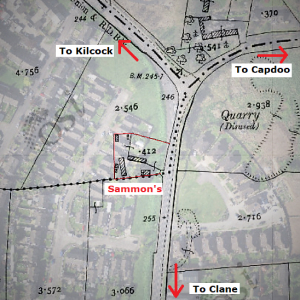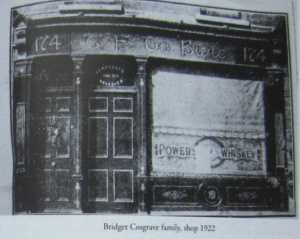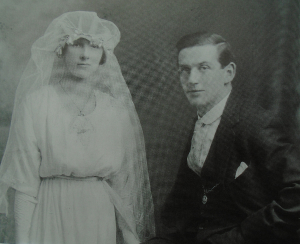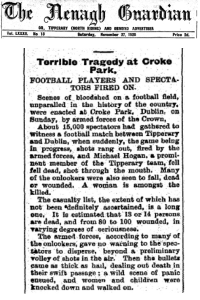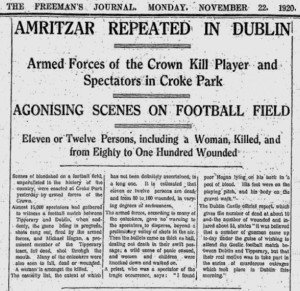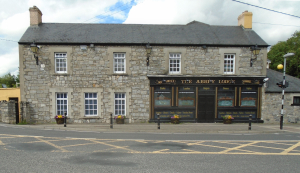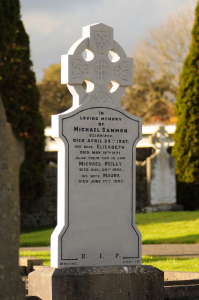Mick Sammon
The Last Man Standing in Croke Park on Bloody Sunday, 1920
Published in LE CHÉILE, December 2020
An edited version published on the GAA website November 2020
Mick Sammon was an important County Kildare figure who made a significant contribution to the Irish Revolution, both as an activist and as a sportsman. Initially imprisoned in 1918, for Irish Volunteer activity, the following year 1919, he was a member of the successful Kildare All-Ireland winning football team. However, his main claim to fame occurred when he was the referee in charge of the football game in Croke Park on Bloody Sunday in November 1920. According to Mick when the firing started – ‘There was a rush from the field, and he found himself standing alone’.
Mick Sammon’s Early Life
Michael Sammon was born in Loughbollard, Clane on the 7th of February 1893 to Thomas Sammon and Bridget Carty.1 He was named after his maternal grandfather Mick Carty from Baltracey. The Sammon (Salmon) family originated in Straffan and were from a rebel background. Mick’s ancestor was among a number of Sammon brothers who were arrested and imprisoned in July 1803 on suspicion of making pikes in Robert Emmet’s Thomas Street depot.2
In the late 1850s, Mick’s grandfather, Maurice, relocated to Loughbollard, Clane.3 By the late 19th century, Clane was a centre of importance in the revival of cultural nationalism where one of the first GAA clubs in County Kildare emerged. Maurice Sammon was enthusiastically involved serving as Secretary of Clane GAA Club in 1891. That year the local Royal Irish Constabulary (RIC) suspected that he was also a member of the Irish Republican Brotherhood (IRB).4 In 1898, when Mick Sammon was five years old, the centenary of the ‘98 Rebellion was celebrated throughout Kildare. Both his grandfather, Maurice, and his father, Thomas, were members of the Clane committee that commemorated the event locally.5
The family tradition, due to having rebel connections and involvement in nationalist activities including Gaelic games, certainly influenced Mick at an early age and clearly was a motivating factor in his later career.
Mick as the eldest son of a farming family in Clane decided against a career in agriculture and chose a profession in the vintner trade. He served his time as an apprentice in the Cosgrave-Burke public house, now Kenny’s Public House, in James’s Street, Dublin opposite the entrance to the South Dublin Union, close to St. James’s Hospital.6 The Cosgrave-Burke family were a strongly nationalist family with County Kildare connections. The owner of the premise, Bridget Cosgrave Burke, was from Landenstown close to Prosperous. The two proprietors of the public house were Frank Burke, Bridget’s second husband, and her eldest son, Willie Cosgrave. Willie was better known as W.T. Cosgrave, later President of the Executive Council of the Irish Free State, 1922–32. In addition to Mick, it is known that the Cosgrave family assisted others from the Prosperous – Clane locality in obtaining employment such as two members of the Cribbin family then employed in senior positions in the staff of the South Dublin Union.7 Mick while serving his time in the premises would be aware of the political involvement of the family. Willie Cosgrave was a Sinn Féin member of Dublin Corporation and this certainly contributed to shaping Mick’s political aspirations.
Having served his time as a barman in James’s Street and later working at the trade in Essex Street8, Mick moved back to County Kildare obtaining a position in Kilcullen. It was in this South Kildare town where he was to make an impact – initially in sport but mainly as a political activist.
Involvement in the National Struggle, 1917–18
The period following Easter Week, 1916 saw a transformation in politics with political support shifting from the Nationalist, Irish Parliamentary Party to the Sinn Féin movement which adopted republican principles. In mid–1917 a branch of Sinn Féin was established in Kilcullen and Mick Sammon was elected Vice-chairman. The following December a South Kildare executive of Sinn Féin was established with Éamon Ó Modhráin as President. Mick Sammon was one of the two delegates attending from Kilcullen and was elected a joint Treasurer on the executive.9 The Volunteer movement also extended throughout every parish in the county and Mick was elected an officer of the local volunteer branch in Kilcullen.
Activity by the Volunteers in County Kildare at this period, 1917–18, was low-key with the role of the Kilcullen branch mainly engaged in drilling exercises. In addition, Mick also had a role delivering dispatches. A system for sending and receiving dispatches from Volunteer headquarters in Dublin to the south of Ireland was devised. Dispatches arriving from the south came through Kilcullen where they were taken in charge by Tom Doran and Mick Sammon who conveyed them to Naas where they were in turn conveyed to the next destination in the direction of Dublin.10
Mick Sammon’s most important activity in the national struggle at this period was his involvement in the general protest against the permit system imposed by the Dublin Castle authorities. During the Conscription Crisis in early 1918 new laws were enacted which made it illegal to hold a meeting or sporting event without having obtained a permit from the RIC. The GAA opposed the measure and successfully outmanoeuvred the authorities on the day known as Gaelic Sunday, the 4th of August 1918. On that day every club in the country held sporting events without seeking the required permit which rendered it impossible for the Castle authorities to arrest or charge a large section of the population.11
Sinn Féin now decided to follow the example of the GAA by holding meetings without permits all over the country on Lady Day, 15th of August at which a statement supplied by headquarters comprising the party’s manifesto should be read out by a prominent local activist at an after Mass meeting. Three meetings in County Kildare were held at Kilcock, Kilcullen and Athy. Activists that read the statement included Michael Stapleton at Kilcock, Mick Sammon at Kilcullen and at Athy a local teacher James J.[JJ] O’Byrne. Mick Sammon was the best known of the three due to his membership of the county football team.12
The RIC in Kilcullen that morning received a tip-off that a meeting was about to be held and Sergeant Doran, who approached Mick making enquiries, was informed by him that a meeting was planned. The meeting was held at the crossroads in the town as the congregation left Mass from the nearby church. It was estimated that between seventy and a hundred people attended with twelve men including Mick on a platform. The meeting began with one of the men calling on Mick Sammon to read the Sinn Féin manifesto and concluded when Mick had finished his address. Two days later, all three men that addressed the meetings in County Kildare were arrested as well as others in different parts of the country.
The three Kildare men were held in custody without trial in the Curragh Camp prison until the 20th of September when they were court marshalled in Portlaoise (Maryborough) Barracks on two charges; first, of taking part in a meeting without a permit and the second, making statements likely to cause disaffection. All three adhered to Sinn Féin-Volunteer policy by not giving recognition to the court. According to a correspondent, Mick Sammon when asked to plead, replied, ‘As an Irishman, I refuse to recognise the court.’13 Two of the men, O’Byrne and Stapleton, were convicted on both charges and sentenced to prison for one year with hard labour. Mick who made no defence was convicted of the first charge only. This may have been because when he was beginning his address at the banned meeting the Sergeant was called back to the barracks to receive a dispatch from the District Inspector and did not fully record his speech. Mick was given a sentence of one month’s imprisonment to run from the 20th of September.14
He served most of the sentence in Mountjoy Jail, Dublin before being transferred on the 10th of October to prison in Belfast. His prison record from Mountjoy provides considerable personal information including his prison number, 813, his height, five foot nine and three-quarter inches, brown hair, blue eyes, fresh completion and his weight, 175 lbs. His occupation was given as a shop assistant and his next of kin was his brother Thomas Sammon from Clane.15 Although the Lady Day meetings were not as successful as Gaelic Sunday as it led to the imprisonment of activists, nonetheless the arrests continued to enhance the status and popularity of Sinn Féin in the in the run-up to the General Election of 1918. Having spent a total of two months in prison, Mick was released in late October. At this point he relocated from Kilcullen to his native Clane taking up residence in the family home in Loughbollard.
Sporting Career, 1917–22
It was with Mick Sammon’s involvement and success as a Gaelic footballer that he made his biggest contribution in life. Little is known of his early footballing activities in Dublin apart from an involvement as a player with Hibernian Knights. In addition, he was a very well-known athlete, specialising in the 100-yard and 220-yard sprints.16 It was following his move to Kilcullen that he blossomed as a Gaelic footballer. The Kilcullen club, known by the nickname ‘The Rags’, had moved up the ranks from junior to senior in 1914 and by the 1917 championship season Mick was captain with his team rivalling the leading senior teams in the county. He led the club to the 1917 county final which was played in January 1918. Their opponents Kilcock virtually consisted of a county team as it included, a number of well-established county players from across the norther section of the county. Each team had superiority in each half, Kilcullen in the first half and Kilcock in the second. Kilcock, however, gained the crucial scores and emerged victorious.
At the beginning of the championship season of 1918, Mick was selected on the county team joining four of the Kilcock players that he had played against in the county final, as well as Larry ‘Hussey’ Cribbin from his native village of Clane, and Larry Stanley who was emerging as one of the leading footballers in the game. This team was to bring All-Ireland success to Kildare the following year, 1919.
Mick’s performance during the 1919 season improved. In addition to partnering Larry Stanley at midfield, he was also the place kicker. His reputation as a place-kicker is best described in a report from the Kildare Observer which stated ‘Sammon is the best man in Ireland to take frees … he leaves it easy for the forwards to score’. The superiority of Larry Stanley, which was the decisive factor in Kildare’s successful championship run, overshadowed the performance of Mick Sammon. The strongest team Kildare faced in the successful championship run was undoubtably Dublin whom they met in the Leinster final. Kildare emerged as victors by the lowest of margins, one point. It was also a low-scoring game in which Kildare gained four scores. Mick had a part in three of the scores. He scored two points from frees and another of his frees found Jim O’Connor who scored the only goal. In the All-Ireland final, on the 28th of September 1919, with outstanding play by Larry Stanley, Kildare defeated Galway on a score of 2–5 to 0–1. Mick’s free-taking devastated the opposition and he not only got on the scoreboard but contributed to the two goals scored by Frank ‘Joyce’ Conlon and Jim O’Connor.17 To win an All-Ireland during the decade of the national struggle was an important contribution for the county and it boosted confidence in the local activists in Kildare who were suffering from the restrictions of having a larger concentration of security forces than any other county in Ireland due to the Curragh Camp.
While 1919 was to date the most high-profile year in Mick Sammon’s career, the following year 1920 was to be even more dramatic. The War of Independence, which began in January 1919, increased with intensity during 1920 particularly following the death on hunger-strike of Terence MacSwiney, on the 25th of October. During this period, GAA inter-county challenge games were held to provide funds for the families affected by the ongoing national struggle and Mick was always ready and willing to offer his services both as a footballer and as a referee.
Throughout 1920 a munitions strike seriously hampered the British war effort. It began when workers refused to operate troop-trains, and this resulted in widescale hardship due to the dismissal of railway staff.18 A football match in aid of the Munition Workers Strike Fund was organised for Croke Park on the 10th of October 1920. The teams taking part were Kildare, the last team to win a senior All-Ireland, and Dublin the team who had recently defeated Kildare in the Leinster final. An understrength Kildare team participated which included Mick Sammon who was only one of five players from the 1919 championship winning team to turn up. Not surprisingly, a near full-strength Dublin team won the game.19
The following month on the 21st of November, Mick was back again in Croke Park, on this occasion as referee for the Tipperary v Dublin challenge match. His expertise was not only confined to his playing abilities, but he also had shown certain capabilities as a referee. The proceeds on this occasion were in aid of the Republican Prisoners Dependents Fund, a cause that was of deep interest to Mick a former political prisoner. The story of Bloody Sunday, both the shooting of British army officers by Michael Collins’s intelligence unit in the morning and the reprisals that followed later in the day with the shooting of civilians in Croke Park by the British Crown forces, is well-known and extensively recorded. The Croke Park game began at 3:15, when Mick threw in the ball. Ten minutes into the game with no score from either side the game was interrupted by the arrival of the Auxiliaries and Black and Tans on the pitch. The subsequent firing by the Crown Forces resulted in the deaths of fourteen people including the Tipperary captain, Mick Hogan.
The only known account of Bloody Sunday by Mick Sammon was an interview given to Michael O’Kelly of the Leinster Leader two weeks after the event. The following details were published:
Congratulations to M. Sammon on his providential escape in the Croke Park tragedy. Many Kildare people are not aware of the fact that Sammon was refereeing the Tipperary v Dublin match on the ill-fated Sunday. In a conversation with the writer shortly after the occurrence he described the terrible scenes. He was speaking to [Michael] Hogan, the ill-fated Tipperary player a moment before the firing broke out and was in the middle of the field near the Clonliffe goal when the first shots rang out overhead. There was a rush from the field, and he found himself standing alone. Proceeding to run from the field he heard shouts of lie down and doing so began to crawl to the side-line. Whilst doing so he passed the body of Hogan, which was lying on his back. All the time volleys were going off all around and people fell in all directions. Having reached the side-line Mr Sammon was called and helped to extricate some girls from the crowd and was eventually searched with other men present. Many girls refused to leave when told they could do so.
Mr Sammon was most emphatic in his denial of the official statement that the shots were first fired from the field.20
Mick Sammon’s graphic account adequately describes the horrific scene in Croke Park. By his own admission, he was the last man standing on the pitch and best positioned to see the panic and terror as people fell in all directions.
The events of Bloody Sunday in Croke Park have not only been compared to the Amritsar massacre in India the previously year but also particularly among Mick’s fellow Kildare folk, to the Gibbet Rath massacre by Crown Forces on the Curragh in 1798.21
The events of that day in Croke Park detailing the atrocity, accounts of the various fatalities including Michael Hogan, and of the various players has received considerable media coverage throughout the years. In contrast, Mick Sammon the referee who was in charge of the game, has received very little coverage although his connection to Bloody Sunday was always highlighted throughout his native County Kildare.
One year later, during the Truce, the challenge match between Tipperary and Dublin was replayed with Mick Sammon once again the referee. Out of respect to the memory of Michael Hogan the players wore crepe armbands.22 The game was officially started by Dan Breen, the legendary Tipperary freedom fighter, and the football used was presented by Mick Sammon.23
During the period from 1919 to 1921, Mick was at the peak of his sporting career. He was recognised as one of the most accurate free takers in the game, in the top class of inter-county midfielders, nationally recognised as one of the best-known referees and he even found time to compete in athletics. At a sports event in Sallins in September 1921, he easily won the highly competitive 100-yard race with seven yards to spare from the second placed competitor, his inter-county teammate George Magan.24
In early November 1920, Mick, in partnership with Paddy Moore, acquired the leasehold of a public house at 73 Fleet Street, Dublin, which was known as The Feathers (later known as the Pearl Bar).25 Although this necessitated moving from Clane to Dublin he still continued initially to play his football with Kildare. However, his work and interests in other activities resulted in football becoming less important. His interest in dogs and coursing increased. In November 1922, two years after Bloody Sunday, Mick continued to gain headlines in the sporting columns – but not as a footballer. It was his success at the Belfast Dog Show where he captured the three first prizes and a reserve with his Kerry blue ‘Suro Blue’.26 It was now a common occurrence to find Mick’s name regularly appearing in non-Gaelic games sporting columns such as coursing events. One of his first successes in coursing was with his greyhound known as Kilmoily at Trim Coursing event in October 1923.27
Mick also found time to assist on various sporting committees. He served on the Tailteann Games Committee which included members of the government and the army. This committee laid the groundwork for the restoration of the ancient Tailteann games.28 When the newly formed National Athletic and Cyclists’ Association of Ireland was formed, he served as treasurer to the Dublin Branch and was for many years a track judge at all the important meetings.29 He also served on a sub-committee appointed at the All-Ireland Congress GAA to consider a scheme, for the formation of a new Irish Athletic Governing Body.30 In addition to serving on the various committees he was also associated with the Kickhams GAA club in Dublin.31
While not engaging directly in politics after 1918, Mick made his views known regarding politics and sport. He favoured the removal of the ban on foreign games by the GAA and publicly made his views known on the issue in an article in 1926 entitled, ‘politics that hamper sport’.32
Throughout the 1920s, Mick continued to referee football matches. He took in charge of the 1923 All-Ireland Junior final which was played in November 1924.33 The following year 1925 he refereed the 1924 All-Ireland Junior semi-final which was played prior to the 1924 senior final. The refereeing in the senior final on that occasion received some criticism, with suggestions that Sammon, whose abilities were described as of a faultless style in the curtain raiser, should have been given charge of the big match.34 In 1938, Mick came out of retirement to referee a veterans’ charity football match, between Clondalkin Round Towers and Lucan Sarsfields, which was in aid of the Palmerstown Church fund.35
In June 1922, Mick married Elizabeth (Lil) Gill a local girl from Butterstream in his native Clane.36 The couple had two daughters, Betty and Maeve. He subsequently sold his interest in The Feathers Bar in Fleet Street and purchased The Railway Hotel (now The Abbey Lodge Pub) in Celbridge settling down to a life as a publican in his adopted town.37 He died in April 1947 at a relatively young age of 54 and is interred in the Franciscan Friary Cemetery, Clane, alongside his child who predeceased him in 1928.38
Footnotes
- Catholic baptismal records, Clane parish.
- Seamus Cullen, The Emmet Rising: Conspiracy, Rebellion and Manhunt in County Kildare, 1802–1806 (Dublin, 2004), pp 95–6.
- Detail from an examination of Tithe applotment books and Griffith Valuation Cancellation Books, Straffan and Loughbollard.
- NAI, RIC Reports 26 Jan. 1891; Clane GAA, a century: A history of the club and people (Clane, 1984), p. 42.
- Leinster Leader, 28 May 1898; Richard Sullivan, ‘Clane in 98’, in Fugitive Warfare (Clane, 1998), p. 172.
- Irish Press, 21 Dec. 1966.
- Seamus Cullen, Bridget Nixon, 1855–1934, in Dublin Historical Record, Vol. LXVI 1&2, pp 86–71.
- NAI, Census of Ireland 1911, Essex St. Dublin.
- Leinster Leader, 15 Dec. 1917.
- Military Archives, Alphonsus Sweeney, BMH WS, 1147, p. 3.
- For details see, Eoghan Corry, Kildare GAA: A Centenary history (Clane, 1984), p. 114.
- Leinster Leader, 24 Aug. 1918. Seamus Cullen, Kildare: The Irish Revolution, 1912–23 (Dublin, 2020), p. 66.
- Leinster Leader, 28 Sept. 1918; Nationalist and Leinster Times, 28 Sept. 1918.
- Leinster Leader, 12 Oct. 1918; Nationalist and Leinster Times, 12 Oct. 1918.
- General register of Prisoners, 1918, (NAI, Mountjoy Prison).
- Irish Press, 21 Dec. 1966.
- For details by various sports correspondents see, Freemans Journal, 29 Sept. 1919; Cork Examiner, 29 Sept 1919; Leinster Leader, 4 Oct. 1919; Nationalist and Leinster Times, 4 Oct. 1919.
- For details on the Munitions Strike see, Seamus Cullen, Kildare: the Irish Revolution, 1912–23 (Dublin, 2020), p. 86.
- Freemans Journal, 11 Oct. 1920.
- Leinster Leader, 11 Dec. 1920.
- Details of the Gibbet Rath massacre see, Mario Corrigan All that delirium of the brave – Kildare in 1798 (Naas, 1997), pp 56–61; Liam Chambers, Rebellion in Kildare, 1790–1803 (Dublin, 1998), pp 83–4.
- Freemans Journal, 21 Nov. 1921.
- Sunday Independent, 20 Nov. 1921.
- Freemans Journal, 30 Sept. 1921.
- Irish Press, 1 Dec. 1966; Leinster Leader, 20 Nov. 1920.
- Freemans Journal, 16 Nov. 1922.
- Leinster Leader, 27 Oct. 1923.
- Irish Independent, 27 March 1922.
- Irish Press, 4 Jan 1967.
- Irish Independent, 17 April 1922.
- Freemans Journal, 16 Nov. 1922.
- Evening Herold, 24 April 1926; Sunday News (incorporating, Lloyd’s Sunday News) 25 April. 1926.
- The Nationalist (Tipperary), 12 Nov. 1924.
- Kerry Reporter, 2 May 1925.
- Evening Herold, 31 Oct. 1938.
- See wedding photograph in Bryan Sammon, Paddy Behan and Liam Burke, Clane the Village we Knew (Dublin, 2006), p. 22.
- Irish Press, 1 Dec. 1966.
- Irish Press, 29 April 1947.

